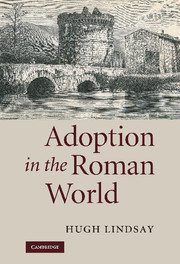Book contents
- Frontmatter
- Contents
- List of figures
- Preface
- List of abbreviations
- Introduction
- 1 Adoption, kinship and the family: cross-cultural perspectives
- 2 Kinship in Greece and Rome
- 3 Greek adoptions: comparisons and possible influences on the Roman world
- 4 Procedural aspects of Roman adoption
- 5 The testamentary adoption
- 6 Roman nomenclature after adoption
- 7 Adoption and inheritance
- 8 Roman freedmen and their families: the use of adoption
- 9 Adoption in Plautus and Terence
- 10 Sallust and the adoption of Jugurtha
- 11 Adrogatio and adoptio from Republic to Empire
- 12 Testamentary adoptions – a review of some known cases
- 13 Political adoptions in the Republic
- 14 Clodius and his adoption
- 15 The adoption of Octavian
- 16 Political adoption in the early Empire at Rome, Pompeii and Ostia; the imperial family
- Conclusion
- Glossary
- References
- Index
10 - Sallust and the adoption of Jugurtha
Published online by Cambridge University Press: 25 January 2010
- Frontmatter
- Contents
- List of figures
- Preface
- List of abbreviations
- Introduction
- 1 Adoption, kinship and the family: cross-cultural perspectives
- 2 Kinship in Greece and Rome
- 3 Greek adoptions: comparisons and possible influences on the Roman world
- 4 Procedural aspects of Roman adoption
- 5 The testamentary adoption
- 6 Roman nomenclature after adoption
- 7 Adoption and inheritance
- 8 Roman freedmen and their families: the use of adoption
- 9 Adoption in Plautus and Terence
- 10 Sallust and the adoption of Jugurtha
- 11 Adrogatio and adoptio from Republic to Empire
- 12 Testamentary adoptions – a review of some known cases
- 13 Political adoptions in the Republic
- 14 Clodius and his adoption
- 15 The adoption of Octavian
- 16 Political adoption in the early Empire at Rome, Pompeii and Ostia; the imperial family
- Conclusion
- Glossary
- References
- Index
Summary
During the Second Punic War Masinissa, king of Numidia, had befriended Scipio Africanus and become beneficiary of the kingdom of the Numidian Syphax and his interests in Africa. Masinissa's own son was Micipsa, but Masinissa also had two brothers, Mastanabal and Guluasa, who had predeceased him. In the next generation, Micipsa had two sons, Adherbal and Hiempsal, but Mastanabal also had a descendant, an older boy, Jugurtha, the son of a concubine.
Jugurtha was duly brought up in the palace, although his status was a little ambiguous because of his maternal heritage, and he was eventually sent to serve in the Roman interest at Numantia in Spain in 134 bc. There, according to Sallust, it was hoped he would meet his fate, and simplify the succession question (Iug. 7). He came back, however, with an enhanced reputation, and a letter of recommendation from Scipio (Iug. 9). Micipsa responded by adopting him, not immediately, as suggested in one passage in the Jugurtha (Iug. 9.3: statim may be intended to indicate a lifetime adoption rather than a testamentary one), but at some time between 121 and 118 bc (Iug. 11.6). He was also made joint heir along with Micipsa's own sons.
Naturally, the case cannot be viewed as a Roman adoption, but it is of interest for the attitudes exhibited by Sallust. Sallust no doubt had mixed feelings about the base-born Jugurtha.
- Type
- Chapter
- Information
- Adoption in the Roman World , pp. 144 - 145Publisher: Cambridge University PressPrint publication year: 2009



